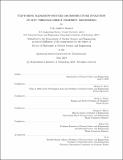| dc.contributor.advisor | Michael P. Short. | en_US |
| dc.contributor.author | Dennett, Cody Andrew. | en_US |
| dc.contributor.other | Massachusetts Institute of Technology. Department of Nuclear Science and Engineering. | en_US |
| dc.date.accessioned | 2020-01-08T19:36:42Z | |
| dc.date.available | 2020-01-08T19:36:42Z | |
| dc.date.copyright | 2019 | en_US |
| dc.date.issued | 2019 | en_US |
| dc.identifier.uri | https://hdl.handle.net/1721.1/123372 | |
| dc.description | This electronic version was submitted by the student author. The certified thesis is available in the Institute Archives and Special Collections. | en_US |
| dc.description | Thesis: Ph. D., Massachusetts Institute of Technology, Department of Nuclear Science and Engineering, 2019 | en_US |
| dc.description | Cataloged from student-submitted PDF version of thesis. | en_US |
| dc.description | Includes bibliographical references (pages 129-138). | en_US |
| dc.description.abstract | Advanced materials development for nuclear systems is currently a time and resource intensive process relying on many iterations of material exposure and destructive testing. There exist few methods for characterizing irradiated material performance in situ, during exposure. Techniques such as in situ TEM or in situ Raman spectroscopy can provide local structural information during irradiation, but no current methods can continuously monitor bulk thermal and mechanical properties. Such a tool would provide the ability to map dose-property relationships at a resolution not previously possible, enhancing mechanistic understanding of irradiation-induced evolution. These methods could also be used to identify the onset of emergent irradiation-induced effects such as the transition from incubation to steady-state void swelling. | en_US |
| dc.description.abstract | For this purpose, we have identified transient grating spectroscopy (TGS) as an appropriate technique to obtain these dose-property relationships during irradiation. This method, by optically inducing and monitoring monochromatic surface acoustic waves on materials under investigation, is able to determine the elastic and thermal transport properties of a microns-thick layer at the surface of a sample, the same depth to which ion beams can impose damage. First, we demonstrated that this method is sensitive enough to measure changes in material properties induced by radiation. Afterwards, we designed new optical geometries which enable second-scale time-resolved TGS measurements on dynamically changing materials. In addition, we developed new analytical methods through which multiple material properties, acoustic wave speed and thermal transport properties, may be extracted simultaneously from single-shot measurements. | en_US |
| dc.description.abstract | As proof-of-principle experiments, ion irradiation-induced property changes have been measured post-irradiation on pure, single crystal copper. In these copper samples, TGS measurements indicate the presence of volumetric void swelling, which is confirmed with scanning transmission electron microscopy (STEM). These developments together show that TGS is capable of capturing irradiation-induced evolution in real time and motivate the design and commissioning of an in situ experiment for ion beam irradiation and TGS monitoring. To this end, an in situ TGS beamline experiment for concurrent ion beam irradiation and property monitoring has been developed on the 6 MV tandem accelerator at the Ion Beam Laboratory at Sandia National Laboratories. The in situ ion irradiation TGS (I3TGS) facility has the ability to monitor material evolution at high temperatures in real time under ion bombardment. | en_US |
| dc.description.abstract | Using high-energy self-ions, we are studying radiation damage effects on the thermomechanical properties of pure metals. In these experiments, irradiation-induced void swelling has been monitored at an orders-of-magnitude finer dose resolution than is possible with traditional methods. This tool has allowed the onset of swelling to be pinpointed in applied dose, a key consideration when developing new materials for use in nuclear systems, on the timescale of days rather than months or years. We are now able to provide the type of rapid, engineering-relevant data necessary to speed the innovation cycle in nuclear materials development. Moving forward, these methods can be used as a screening tool to expedite the design and testing process for advanced nuclear materials. | en_US |
| dc.description.statementofresponsibility | by Cody Andrew Dennett. | en_US |
| dc.format.extent | 138 pages | en_US |
| dc.language.iso | eng | en_US |
| dc.publisher | Massachusetts Institute of Technology | en_US |
| dc.rights | MIT theses are protected by copyright. They may be viewed, downloaded, or printed from this source but further reproduction or distribution in any format is prohibited without written permission. | en_US |
| dc.rights.uri | http://dspace.mit.edu/handle/1721.1/7582 | en_US |
| dc.subject | Nuclear Science and Engineering. | en_US |
| dc.title | Capturing radiation-induced microstructure evolution in situ through direct property monitoring | en_US |
| dc.type | Thesis | en_US |
| dc.description.degree | Ph. D. | en_US |
| dc.contributor.department | Massachusetts Institute of Technology. Department of Nuclear Science and Engineering | en_US |
| dc.identifier.oclc | 1134988450 | en_US |
| dc.description.collection | Ph.D. Massachusetts Institute of Technology, Department of Nuclear Science and Engineering | en_US |
| dspace.imported | 2020-01-08T19:36:35Z | en_US |
| mit.thesis.degree | Doctoral | en_US |
| mit.thesis.department | NucEng | en_US |
